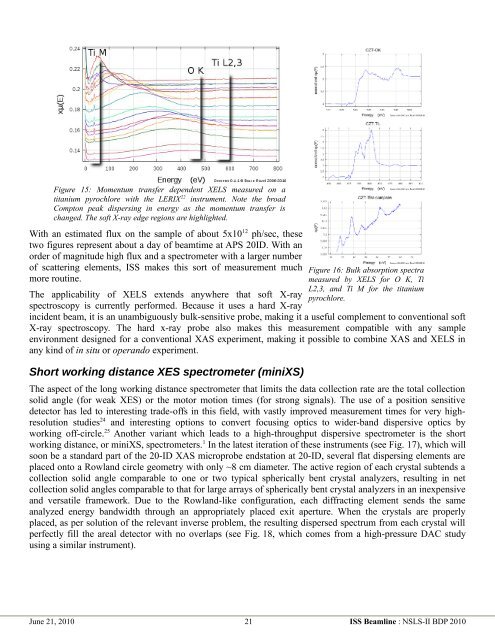Inner Shell Spectroscopy (ISS) - Brookhaven National Laboratory
Inner Shell Spectroscopy (ISS) - Brookhaven National Laboratory
Inner Shell Spectroscopy (ISS) - Brookhaven National Laboratory
Create successful ePaper yourself
Turn your PDF publications into a flip-book with our unique Google optimized e-Paper software.
Figure 15: Momentum transfer dependent XELS measured on a<br />
titanium pyrochlore with the LERIX 22 instrument. Note the broad<br />
Compton peak dispersing in energy as the momentum transfer is<br />
changed. The soft X-ray edge regions are highlighted.<br />
With an estimated flux on the sample of about 5x10 12 ph/sec, these<br />
two figures represent about a day of beamtime at APS 20ID. With an<br />
order of magnitude high flux and a spectrometer with a larger number<br />
of scattering elements, <strong>ISS</strong> makes this sort of measurement much<br />
more routine.<br />
The applicability of XELS extends anywhere that soft X-ray<br />
spectroscopy is currently performed. Because it uses a hard X-ray<br />
incident beam, it is an unambiguously bulk-sensitive probe, making it a useful complement to conventional soft<br />
X-ray spectroscopy. The hard x-ray probe also makes this measurement compatible with any sample<br />
environment designed for a conventional XAS experiment, making it possible to combine XAS and XELS in<br />
any kind of in situ or operando experiment.<br />
Short working distance XES spectrometer (miniXS)<br />
Figure 16: Bulk absorption spectra<br />
measured by XELS for O K, Ti<br />
L2,3, and Ti M for the titanium<br />
pyrochlore.<br />
The aspect of the long working distance spectrometer that limits the data collection rate are the total collection<br />
solid angle (for weak XES) or the motor motion times (for strong signals). The use of a position sensitive<br />
detector has led to interesting trade-offs in this field, with vastly improved measurement times for very highresolution<br />
studies 24 and interesting options to convert focusing optics to wider-band dispersive optics by<br />
working off-circle. 25 Another variant which leads to a high-throughput dispersive spectrometer is the short<br />
working distance, or miniXS, spectrometers. 1 In the latest iteration of these instruments (see Fig. 17), which will<br />
soon be a standard part of the 20-ID XAS microprobe endstation at 20-ID, several flat dispersing elements are<br />
placed onto a Rowland circle geometry with only ~8 cm diameter. The active region of each crystal subtends a<br />
collection solid angle comparable to one or two typical spherically bent crystal analyzers, resulting in net<br />
collection solid angles comparable to that for large arrays of spherically bent crystal analyzers in an inexpensive<br />
and versatile framework. Due to the Rowland-like configuration, each diffracting element sends the same<br />
analyzed energy bandwidth through an appropriately placed exit aperture. When the crystals are properly<br />
placed, as per solution of the relevant inverse problem, the resulting dispersed spectrum from each crystal will<br />
perfectly fill the areal detector with no overlaps (see Fig. 18, which comes from a high-pressure DAC study<br />
using a similar instrument).<br />
June 21, 2010 21 <strong>ISS</strong> Beamline : NSLS-II BDP 2010
















